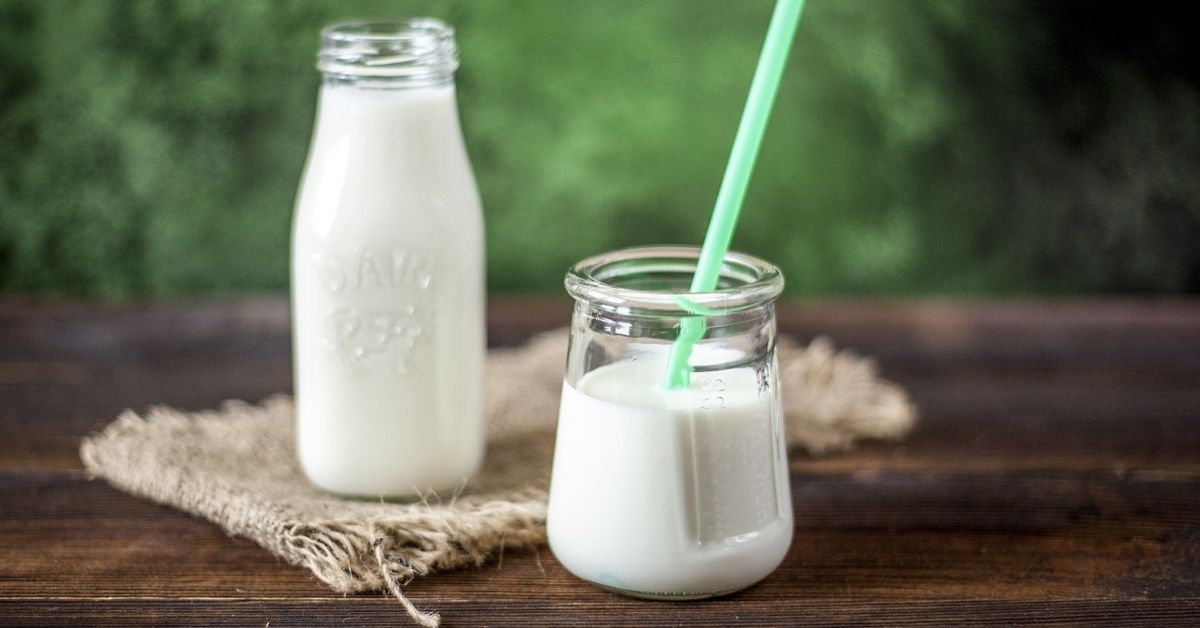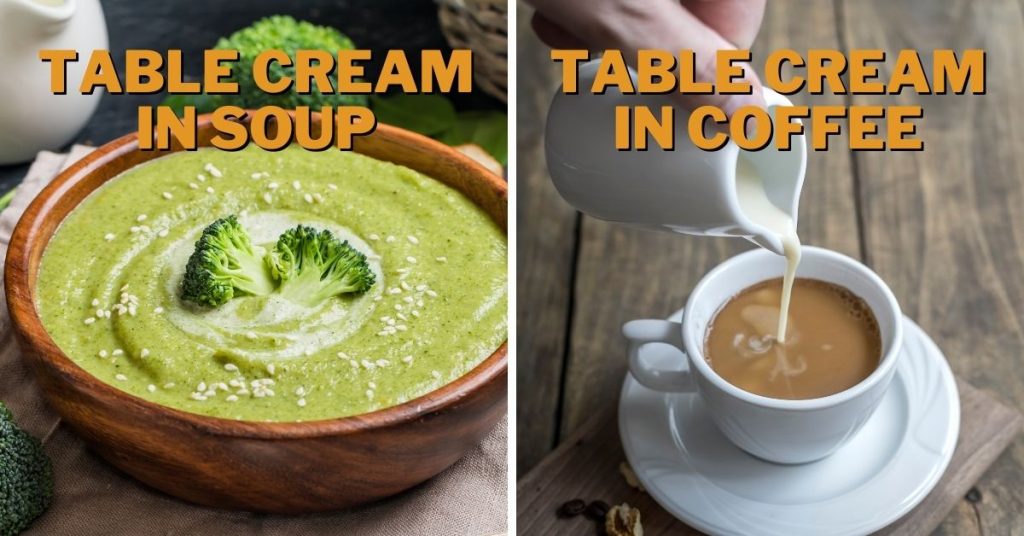What Is Table Cream & How to Use It?

We put the cream into so many of our foods, from a cup of coffee to decadent desserts like tiramisu and cheesecake. And you will notice how there are different types of cream for different recipes. One such variety is called table cream. So, what exactly is a table cream product?
Table cream is a type of cream that contains 18 to 30% of milk fat. Typically, this is the cream that people use in their coffee. As such, this product is also called “coffee cream” or light cream. Additionally, you can drizzle this cream over a slice of cake or pie.
Table cream or light cream functions differently than other types of cream. And knowing this difference will help you choose the right one for your needs. So, in this article, we are going to break apart table cream and discuss how it is made, when it is used, and what you can substitute it with.
What Is Table Cream Used For?
Table cream is another name for light cream, which is cream that contains 18 to 30% milkfat in weight. This cream is commonly used to make coffee even richer and creamier. Thus, many refer to this product as “coffee cream”. As it is a liquid, you can infuse it directly into your coffee or any other drink without needing to melt it or process it.
What is table cream also used – to make different curries and sauces. For example, you can pour this milk into butter chicken for a truly decadent dish. So, table cream is a product that works perfectly with both sweet and savory dishes.
Speaking of desserts, you can add light cream to dishes such as puddings and custards. If your recipe calls for whole milk or condensed milk, you can substitute it with light cream for an even richer experience. Just be mindful of the extra fat and calorie content.

Table cream is sometimes used as a substitute for heavy cream by infusing it with melted butter. The butter increases the amount of fat in the cream to make it more similar to heavy cream.
Can You Use Table Cream for Cooking?
You can use table cream for cooking things such as sauces, soups, and curry. But one thing you have to be mindful of is the temperature. You do not want to let the cream reach its boiling point. Otherwise, the cream may end up breaking apart and ruin the consistency of your sauce.
So, if you want to add cream to a sauce or curry, then pour it when the sauce is just simmering on the stove. Gently cooking the sauce and not stirring too much will ensure that the cream stays intact.
Alternatively, you can add the cream for a minute or two before taking the sauce off the heat. This way you can still enjoy a super-rich texture without making the sauce curdled.
How to Use Table Cream?
Table cream is sort of the lighter version of heavy cream. Despite its name, table cream still contains significantly more fat than half-and-half or evaporated milk. But compared to heavy cream and whipping cream, the fat level is almost half. And this distinction is important to know when you want to use table cream.
Table cream exclusively comes in a liquid form. So, you can directly pour it into coffee and other drinks. Likewise, you can pour it on top of a slice of cake or pie to make the taste even richer.
However, since most brands of table cream fall short of 30% fat, you will be unable to whip it. So, you will not be able to make things such as meringue or tiramisu.
For example, you need at least 30% milk fat in a cream product to make a stable whipped cream. So, you can easily whip heavy cream and give it a more solid form. In fact, whipped heavy cream is more stable than actual “whipping cream”. But if you try to whip light cream, it will not foam up.
For reference, products that are sold under the name of “whipping cream” have at least 30% milkfat, usually more. Similarly, products such as heavy cream, clotted cream, and double cream, all have enough fat in them to make a stable foam.
This is why you need heavy cream to make desserts like cheesecake and tiramisu. Because you need the cream to hold its shape when you whip it. Light cream is preferable to a coffee creamer as you can directly pour it into the drink.
You can add this cream to soups and sauces to make them taste creamier. But you have to be careful not to boil the cream. Otherwise, the cream may end up curdling due to its low levels of fat. So, when you do add this cream to your sauce, it is best to add it near the end and cook it gently.
What Is Table Cream Made Of?
Traditionally, most edible creams are made out of milk, typically cow’s milk. Specifically, the cream is the layer of fat that is present in the milk. And depending on how much of this fat persists in the production process, you get different types of cream with different labels for each.
So, table cream is a cream that has anywhere between 18 to 30% of milk fat. Meaning, that 18 to 30% of its total weight is just fat from the milk. The rest of the cream is water, some milk protein, some carbohydrates, etc. Most manufacturers remove the protein and salt from their table cream.
Now, if the cream had any more than 30% fat, it would be classified as whipping cream. Any lower than 18%, and you would end up with sour cream or half-and-half. The last two are similar to table cream in many ways. But the key thing to notice is how much fat is in it.
What Are Table Cream Substitutes?
Light cream is a super-easy way to make a cup of coffee or a batch of butter chicken rich and delicious. But what happens if you do not have some at your disposal and what is a table cream substitute? Well, you can try any one of the alternatives we are going to list below:
Half-and-Half
Half-and-half is the best substitute for light cream in coffee or any other drink. It has pretty much the same consistency although noticeably less fat. Half-and-half contains about 12-18% of fat. So, it is one grade below table cream.
But you will still get that rich and creamy taste with half-and-half. And the amount you use is pretty much identical.
Whole Milk and Butter
Whole milk does not have nearly the same amount of fat as table cream. But that is where the butter comes in. By mixing whole milk with melted butter, you drastically raise the fat level in the milk solution. You can then use this solution to your sauces and curry without worry!
As a general rule, for every cup of light or table cream, incorporate 3 tbsp of butter to 7/8 cup of whole milk.
Evaporated Milk
Evaporated milk or unsweetened condensed milk is what you get when you remove most of the water from whole milk. The result is a thick and very rich liquid that is very effective at replicating the effects of cream. You will not get the same amount of fat. But this substitute is perfect for creating that rich and creamy taste in coffees and cakes.
Full-Fat Coconut Milk
Now we have a non-dairy substitute for table cream in full-fat coconut milk. This is especially ideal for people who are either vegan or intolerant to dairy.
Do keep in mind that this substitute is going to have an additional coconutty taste whereas regular table cream tastes more like milk. This gives coconut milk an extra dimension of taste and texture. But it also means that this is not the ideal substitute for table cream in every scenario.
Is Media Crema Table Cream Evaporated Milk?
Media Crema is a product of the Nestle company and it is their version of table cream. According to the label, Media Crema has 4 grams of fat per 15 ml of serving. Meaning it has a fat content of about 27%, which qualifies as actual light cream or table cream. This is different from their Carnation line of products, which is evaporated milk.
Is Table Cream the Same As Heavy Cream?
Despite the two varieties sharing some similar applications in a kitchen, heavy cream and table cream are not the same product. In heavy cream, there has to be at least 36% milk fat or else it will not be classified as such. In contrast, table cream or light cream has 18 to 30% milk fat, usually around 20%.
Can You Whip Table Cream?
In order to whip cream into a stable foam, there has to be at least 30% milkfat in the cream. And though technically table cream can have close to 30% fat content, most such products fall well short of that percentage. As such, you cannot whip typical table cream. If you try to whip it continuously, the cream will end up curdling instead of foaming up.
Can You Use Table Cream for Pasta?
You can use table cream in a pasta dish, particularly when making the sauce for the pasta. But as we have mentioned before, you have to be careful not to overcook or boil the cream. Gently add the cream to the sauce and incorporate it slowly to make the sauce richer and creamier.
To conclude, table cream is a terrific option to have at your disposal. You can add it to so many dishes, from savory to sweet, and instantly be rewarded with a rich and decadent experience for your palate.
